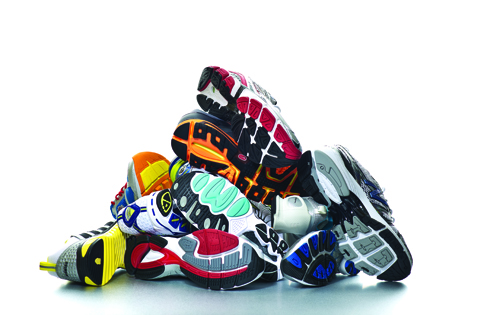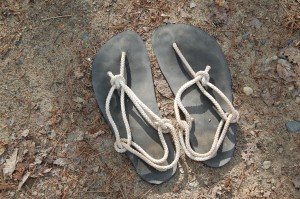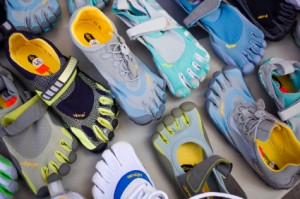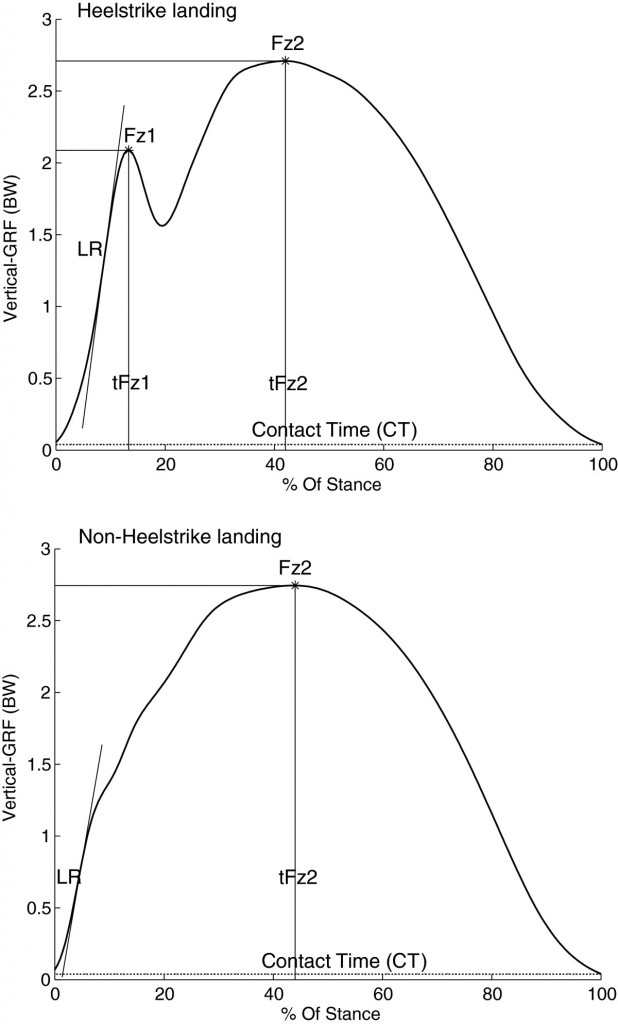Running Shoe Controversy

Tips For Adapting to Barefoot Running
- It might take as long as 6-9 months to develop adequate muscle strength to run long distances with no shoes or minimalist shoes.
- Never progress more than 10% in time or distance ran over the course of 1 month.
- Strengthen the lower extremities with a high repetition/low resistance routine to combat the catabolic effects of running.
- Seek treatment from a Physical Therapist should a running injury occur. They can uncover the true cause of the injury and help to speed up your recovery.
Running Shoes and Running Techniques
Very few activities combine the calorie burning, diabetes smashing, cardiovascular disease crushing and stress relieving health punch that regular running provides. And over the past several decades, the masses have flocked to running at a breakneck rate. In fact, despite the recent worldwide economic slowdown, the number of people who run regularly continues to grow at a record pace. For this reason, running has been called “recession proof”. The health benefits notwithstanding, the sustained growth of the sport in this uncertain economy may very well be attributable to the low startup cost for running. “Have shoes . . . will run” is the common mantra.
In 2011, more than 28 million people in the US put foot to pavement regularly, running at least 50 days out of the year. These runners purchased more than 38 million pairs of running that same year. Due to the high demand, running shoes has become a major global industry, with sales of $2.5 billion dollars last year. This has created somewhat of a dilemma for consumers, as companies jockey to gain their attention with the newest “innovations”. Many companies have invested heavily in research and development in an effort to stay ahead of the competition. Despite these “advances”, runners continue to experience overuse injuries, and are often forced to stop running.
HISTORICAL PERSPECTIVE
Seemingly, in defiance of the recent trends, the Tarahumara people of Mexico have been known to run extensive distances (up to 400 miles in 48 hours) barefoot, or with nothing more than rubber Huarache sandals. These people continue to run great distances and do not appear to experience the leg injuries that are very common in people who run in modern running shoes.
THE BARE (FOOT) TRUTH
 In this blog we will explore the differences between the “shod runner” (ie modern running shoes) and the barefoot or minimalist runner. And we will see if we can answer this very question.
In this blog we will explore the differences between the “shod runner” (ie modern running shoes) and the barefoot or minimalist runner. And we will see if we can answer this very question.
There are significant differences in the running style of people who run in modern “high tech” running shoes and those who run in minimalist shoes or barefoot. Almost all shod runners will contact the ground with their heel first or better known as a “heel-striker.” Other runners will contact the ground in a “flat foot” manner or on the metatarsal heads. These runners are known to be “mid-foot” or “fore-foot strikers.” The difference in foot position upon striking the ground might be the key factor that appears to be the reason for a decrease in the number of lower extremity injuries in the later groups. The vertical ground reaction force (VGRF) that occurs when a shod runner’s heel strikes the ground is significantly higher. The peak VGRF is highest in the shod runner, also. It is simple to reason that a runner with very little or no protection on their foot will not land on their heels or with a high VGRF because it hurts.
HOW CAN SHOES BE HARMFUL
The “high tech” running shoe affects the running form in numerous ways. Shod runners might have longer stride lengths, stiffer leg response and weaker intrinsic foot muscles. The cushioned heel allows the runner to stride to their maximum length without experiencing a great deal of pain upon heel strike. Our lower extremities respond to high impact forces by “softening” the landing by enabling the muscles to absorb more of the shock. Conversely, if the surface is soft and cushioned, the muscle response will be to “stiffen” the lower extremity. Lastly, if the foot is supported by “high tech” counters, cushion and other controlling aspects of the modern running shoe, the intrinsic muscles of the foot don’t have to work very hard. The argument against prophylactic bracing is that the muscle structure of the “braced” joint will become dependent upon the brace and weaken over time. Like wise the foot muscles might weaken if they are always supported by a modern, “high tech” running shoe.
MINIMALIST SHOES TO THE RESCUE?
 The non-shod runner has a totally different landing technique. They land on the mid or forefoot because it is more comfortable. Their stride length is shorter and they will need to incorporate more strides into the same distance. This technique enhances the muscle activation in the lower extremity. Due to the increased muscle activity and “softer” landing the initial VGRF is significantly less and “ramps up” over a longer time period (Figure 1). These factors appear to be the main reason for fewer lower extremity injuries in the non-shod runners.
The non-shod runner has a totally different landing technique. They land on the mid or forefoot because it is more comfortable. Their stride length is shorter and they will need to incorporate more strides into the same distance. This technique enhances the muscle activation in the lower extremity. Due to the increased muscle activity and “softer” landing the initial VGRF is significantly less and “ramps up” over a longer time period (Figure 1). These factors appear to be the main reason for fewer lower extremity injuries in the non-shod runners.
Shod runners have dealt with numerous impact and over-use type injuries for years. They commonly experience tendinitis, bursitis and stress fractures throughout the lower extremity. The recent studies indicate that these injuries might be due to improper training and/or too much impact force upon landing. It is quite clear that the VGRF is significantly higher upon impact and does not “ramp up” to the peak force (Figure 1). The number of injuries has not been reduced regardless of the increase in “high tech” advances in the modern running shoe.

Figure 1. Outcome measures in a typical vertical ground-reaction force (GRF) curve for a heelstrike runner and a non-heelstrike runner. Figure is created from personal data.
PROCEED WITH CAUTION or SMART TRAINING
There is a down side to running without a shoe or with a minimalist shoe. Obviously the foot can experience more skin damage. Many runners who make the switch to this type of running style attempt to run the same distances that they are accustomed to running with a running shoe on and this leads to over-use type injuries. The entire lower extremity must be “trained” to be able to handle the increased load on the muscle structure and tendon tissue. Most Physical Therapists have treated a large increase in lower extremity over-use injuries that are directly related to over training or improper progression of training during the transition.
WHEN IN DOUBT, TALK TO YOUR PHYSICAL THERAPIST
Physical Therapists can help you transition to a better running technique. They can assess your gait and help you change it if necessary. It takes a long time to correct or change one’s gait to reduce the abnormal stress and strain on the lower extremity joints. In the event of an injury, the Physical Therapist will evaluate your condition to discover the true cause of the problem and treat the symptoms. The therapist might use braces, tape, orthotics and running shoes initially to facilitate healing of the injured tissue. Strengthening and stretching of the muscles of the core, hips and entire lower extremity is a necessary part of training. Running alone is catabolic and will eventually cause a “break down” in the soft tissues of the lower extremity if additional exercises are not incorporated into the training program.
Running is a popular cardiovascular exercise, but most runners experience an injury sometime in their running “careers.” It appears that the modern day “high tech” running shoe cannot prevent the lower extremity injuries and there is evidence that supports running in minimalist shoes or bare feet might help to reduce the frequency of lower extremity injuries.

























I think you can get a better sense of what I’m syaing about midstance versus impact from my Rest of the Story post . What we observed was very straightforward: the peak pressures across all the common sites for injuries including stress fractures (e.g. tibial and metatarsal) and osteoarthritis (e.g. knee osteoarthritis) occur at midstance, not at impact.
A very informative and potential help to minimize injuries of your lower extremities particularly your running feet. Crom